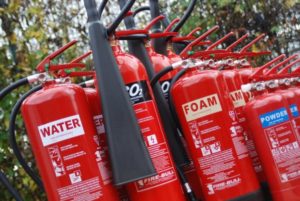Four in 10 construction workers use the wrong type of fire extinguisher on electrical fires
Nearly four in 10 (38%) construction workers are using the wrong type of fire extinguisher to deal with electrical fires, a survey has revealed.
Commissioned by Bull Products, the survey found that 10% would use a foam extinguisher to put out an electrical fire.
Foam extinguishers are better suited to dealing with fires involving paper, wood, cloth, or plastic, as well as flammable liquids like paraffin, petrol, and oil. Smothering the fire with a foam film, they starve it of oxygen and cool burning materials.
Another 27% used ABC powder fire extinguishers (or dry powder extinguishers), which are suited to solids, flammable liquids and flammable gases – Class A, B, and C fires. They should never be used in small, confined spaces if there is a risk of inhaling the powder.
Both types of fire extinguisher can badly damage equipment that may be unaffected by the fire itself.

 Canvassing the views of site managers and supervisors, and health and safety managers/officers, among others, the survey also revealed that 8% admitted they didn’t know which fire extinguisher they should use and 7% were unaware of the universal colour-coded system for fire extinguishers.
Canvassing the views of site managers and supervisors, and health and safety managers/officers, among others, the survey also revealed that 8% admitted they didn’t know which fire extinguisher they should use and 7% were unaware of the universal colour-coded system for fire extinguishers.
“Each year, there are 40,000 fires in the workplace, which can put the lives of workers at risk but using the wrong type of fire extinguisher can also have major consequences,” said Bradley Markham, director at Bull Products, which specialises in developing life safety equipment for the industry.
“Not only can it maximise the spread of a fire, it can cause major damage to a site and equipment, thus costing companies millions of pounds to repair the damage.
“On an electrical fire, a C02 fire extinguisher is the safest option as it leaves no residue and is an ideal solution for extinguishing fires involving electrical appliances as it does not cause damage to the site.
“Using the correct fire safety equipment is of utmost importance, and it’s crucial that health and safety managers train workers so that everyone on site is aware and understand what type of fire extinguishers to use and in what situation.”
This article was originally published on our sister site, IFSEC Global, here.
[vc_row][vc_column width="2/3"][vc_column_text]
Fire Safety in 2023 eBook
SHP's sister site, IFSEC Insider has released its annual Fire Safety Report for 2023, keeping you up to date with the biggest news and prosecution stories from around the industry.Chapters include important updates such as the Fire Safety (England) Regulations 2022 and an overview of the new British Standard for the digital management of fire safety information.Plus, explore the growing risks of lithium-ion battery fires and hear from experts in disability evacuation and social housing.[/vc_column_text][vc_empty_space][vc_btn title="Click here for more information and to view this Fire Safety eBook" color="danger" link="url:https%3A%2F%2Fwww.ifsecglobal.com%2Fresources-1%2Ffire-safety-report-2023-is-industry-ready-to-embrace-safety-culture%2F|target:_blank"][/vc_column][vc_column width="1/3"][vc_empty_space][vc_single_image image="88417"][/vc_column][/vc_row]
Four in 10 construction workers use the wrong type of fire extinguisher on electrical fires
Nearly four in 10 (38%) construction workers are using the wrong type of fire extinguisher to deal with electrical fires, a survey
Safety & Health Practitioner
SHP - Health and Safety News, Legislation, PPE, CPD and Resources 
Don’t blame the users, they only utilise what has been provided.
In over 40 years of risk management work and fire surveying for the insurance industry I have frequently come across unsuitable extinguishers for the environment, as installed and recommended by the suppliers. Dry powder frequently appears to be regarded as a universal fire extinguishing material. Provision of dry powder where it can cause damage to equipment or contamination to materials is particularly frequent. Typical examples include dry powder found in offices and computer areas as well as in food manufacturing and clean room areas.
Please, educate the suppliers and installers to provide appropriate equipment.
Is the end user actually trained to use a fire extinguisher. Maybe this is the cause of the issue.
I don’t disagree at all, but still feel that people will use what they find comes to hand.
Incidentally I found only this morning fire blanket and dry powder units located in small works breakroom/kitchen area containing electric kettle, microwave oven, electric hot plates and toaster. Extiguishers as installed by supplier and recently maintained.